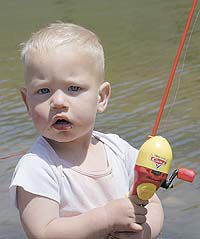| One year old Brandon Johnson fishes at Electric Lake. |
•Abajo Mountains. Rapalas or spoons are recommended for Recapture pike. Fishing has been good at Monticello and Foy reservoirs with spinners and artificial flies. Conservation Officer Paul Washburn described fishing as “hot” at Blanding number three and number four reservoirs with worms.
•Benches Reservoir. Try a worm and bubble or nightcrawler/PowerBait combination.
•Boulgers Reservoir. A worm/ marshmallow or worm/PowerBait combo is recommended.
•Cleveland Reservoir. Morning fishing is best with a worm/PowerBait combo.
•Duck Fork Reservoir. Fishing was slow over the weekend, due to inclement weather. Tigers get up to 17-inches. Special regulations apply. Refer to the proclamation.
•Electric Lake. Try a nightcrawler/salmon egg combo on the north end.
•Fairview Lakes. Try floating PowerBait floated off the bottom with a slip sinker. A red crystal bugger on sinking line has been good for fly casters.
•Ferron Reservoir. Fishing was slow over the weekend, due to rain and windy weather.
•Green River. Cast pieces of nightcrawler into eddy pools for lots of 12-inch catfish.
•Huntington Creek. Good fly patterns include a: number 10 beadhead Montana, number 12 beadhead hare’s ear, or number 12 beadhead ugly. Special regulations exist on Huntington Creek. Please consult the proclamation.
•Huntington North State Park. For trout, try a worm/PowerBait combo. Catfish are biting on nightcrawlers or chicken livers. Two record catfish, weighing 25 and 27 lbs. apiece were taken in August.
•Mammoth Reservoir. Fishing has been slow in the past month but is expected to improve with cooler weather. Special regulations apply. Please refer to the proclamation.
•Joes Valley Reservoir. The best year-round bait is a Utah chub, which can be caught at the reservoir with a small hook and piece of worm.Special regulations apply. The limit is two fish. Only one may be over 22 inches. All trout from 15-22 inches must be immediately released.
•Lake Powell. After months of water temperatures in the 80’s significant cooling has dropped surface temperature to 75. That’s a very active temperature for warm water sport fish. Larger fish that do not like the warm surface layers were forced to stay deep. They can now go anywhere they desire.
That’s timely because dropping lake levels are stranding weed beds which house the main food source. Sunfish hiding in the weeds are now forced into deeper water making them vulnerable to predation as they leave the drying weeds for the next deeper spot. Find a weedy cove for good fishing. That’s not always easy with Powell’s steep rocky shoreline. Weeds will be in flat-bottomed sandy coves.
Largemouth bass are in the shallow weeds with the sunfish. A surface popper slowly retrieved with many pauses will draw strikes from bass up to five pounds. Smallmouth bass wait on the rocky edge of the cove for sunfish to venture beyond the safe limits of the weeds. Plastic baits that are rigged in a weedless fashion that can penetrate the weeds without hanging up are needed to fish the shallows, but grubs on jigheads can be worked at the edge and in open pockets with good success.
Striped bass are aware of sunfish in the weeds but they are clumsy when chasing prey there. In weed beds stripers end up with salad as the main course. Look for stripers near weed beds but holding further out on the second terrace. The weedy cove will often have a flat that extends from shore to near 15 feet. Depth will drop quickly at the edge of the weeds to 20 or 25 feet. Stripers will be found at the next break where depth falls to 30 or 40 feet.
Position the boat over the breaking edge and cast toward shore for bass and toward the channel for stripers. Spoons are the best choice for stripers since they fall quickly from surface to deep water. Active stripers can be found by reeling the spoon quickly off the bottom. Pause the spoon a time or two during the retrieve to entice following fish to bite.
When stripers stop hitting spoons they can be reactivated by using anchovy chum and bait to catch more fish resting on the bottom. Trolling the 30-foot contour with deep diving plugs is another effective method of locating striper schools.
Boils are still happening morning and evening but not every day. There is enough inconsistency that finding a boil is a very special event. Boils have been very good when located with numerous schools feeding on top from dawn to 8 a.m.
A return to the same spot the next day does not mean the stripers will repeat the event. Circumstances have to be just right for stripers to find a large shad school when the forage fish are scarce and hiding.
•Lasal Mountains. Conservation Officer TJ Robertson reports that smallmouth bass action is improving on the northwest side of Ken’s Lake. Robertson recommends a brown Yamamoto doubletail plastic grub with green speckles. Trout are biting on worms and PowerBait. Robertson says there has been a lot of fishing pressure at Hidden and Dons lakes. Trout have been taking just about anything. In the early morning, fly fishermen have had good luck at Dons. Try worms or PowerBait at Dark Canyon. A black wooly bugger or PowerBait is recommended for Warner Lake.
•Petes Hole. Good fishing is expected. Try worms and salmon eggs.
•Potters Pond. Try a PowerBait/crawler combo.
•Scofield Reservoir. Most boaters continue to still-fish with a crawler/PowerBait combo. Trollers have been using needlefish or triple teasers among other types of hardware. Fly fishermen should try dark-colored wooly buggers or leeches on sinking line.
•Willow Reservoir. Conservation Officer Casey Mickelsen reported good fishing with worms, flies and PowerBait. Rainbows are around 10-12 inches.

